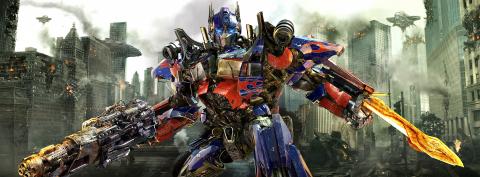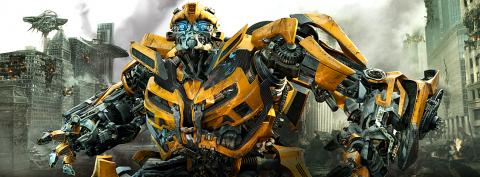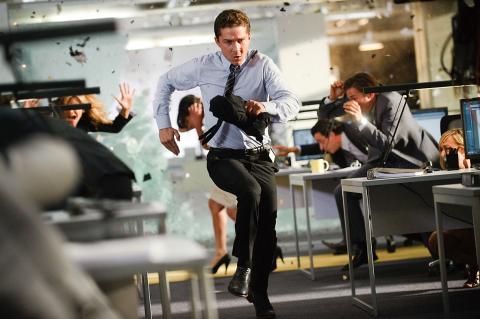With Transformers: Dark of the Moon, Michael Bay’s talent for directing loud, spectacular and essentially meaningless films has entered a new dimension, if only that of 3D. He can now be more in your face than ever. In addition, for local audiences, one of the big draws of the film will be screenings at the refitted Ambassador Cinema (國賓大戲院) in Ximending (西門町), where the bombastic score and cacophony of endless fight sequences puts the cinema’s new Dolby 7.1 surround sound system through its paces.
In this third and hopefully final installment of the Transformers trilogy (based on a line of toys created by Hasboro in the 1980s), Bay has pulled out all the stops, cramming everything in from his rather limited directorial repertoire, and taking big action and ham-fisted drama further than ever before.
In Dark of the Moon, Bay has tried to provide both a prequel and a finale to the story of a nation of robots that continues to fight a civil war on Earth, with one faction allying itself with humans, represented by the US government, and the other aiming at the enslavement of humanity for its own ends.

Photos courtesy of UIP
Some of the old characters have returned. There is of course Shia LaBeouf as Sam Witwicky, who manages to be less appealing than ever, but also John Turturro as Simmons, a rogue CIA agent who provides one of the very few examples of actual acting to be found in the film. The gags he is given are neither new nor particularly funny, but the attempts at humor are a blessed, if only momentary, relief from the rest of the movie. Other attempts at humor, provided by Ken Jeong as a NASA scientist controlled by the bad robots, and a nutty corporate boss play by John Malkovich, with their broad, frat-boy humor, seem to be part of another movie entirely.
A new arrival in the movie is Rosie Huntington-Whiteley (Carly), who passes for the film’s romantic interest. Romance is a bit too strong a word, really, for the Victoria’s Secret lingerie model does nothing more than look sultry and sexy. Then again, Bay’s lad mag sensibility deprives her even of these qualities, as the camera pans up her thigh to get a look at her knickers. Huntington-Whiteley is much better to look at than either LaBeouf or any of the CGI robots, but she can’t act for nuts and Megan Fox, who provided titillation in the first two Transformer movies, seems a paragon of acting talent by comparison.
Dark of the Moon roots its fantasy in conspiracy theories about the Apollo 11 landing, and goes so far as to employ footage of JFK, Nixon, the Apollo 11 landing, and an actual appearance of Apollo 11 astronaut Buzz Aldrin. Bay also includes a minor narrative detour involving Russian cosmonauts living anonymously in the US, which is all part and parcel of Bay’s everything-and-the-kitchen-sink attitude to building up his latest box office monster.

Photo courtesy of UIP
At the same time, there are passages of high-flown rhetoric about freedom and humanity that cheapen patriotism and self-sacrifice in ways still undreamt of when Bay was making Pearl Harbor. While irony may or may not be intended in some or all of the above (I think fondly of Paul Verhoeven’s Starship Troopers), there simply isn’t any kind of unifying consciousness to give this mishmash of elements any cohesion.
One could go on and on about the faults of Dark of the Moon, but it has to be said that some of the battle sequences are impressive (even if too long), and that Bay has used 3D in a manner that makes the most of its immersive qualities. A scene with special ops troops in winged flying suites descending on a devastated Chicago is truly memorable, and beats anything since Avatar for breathless wonder at cinema’s technical achievements. Having said that, it should be noted that given that most of the film’s appeal is in Bay’s command of these technical rather than narrative aspects of the film, Dark of the Moon should only be seen at a cinema supporting the 3D format. Otherwise, it cannot but fall flat.

Photo courtesy of UIP

The canonical shot of an East Asian city is a night skyline studded with towering apartment and office buildings, bright with neon and plastic signage, a landscape of energy and modernity. Another classic image is the same city seen from above, in which identical apartment towers march across the city, spilling out over nearby geography, like stylized soldiers colonizing new territory in a board game. Densely populated dynamic conurbations of money, technological innovation and convenience, it is hard to see the cities of East Asia as what they truly are: necropolises. Why is this? The East Asian development model, with

June 16 to June 22 The following flyer appeared on the streets of Hsinchu on June 12, 1895: “Taipei has already fallen to the Japanese barbarians, who have brought great misery to our land and people. We heard that the Japanese occupiers will tax our gardens, our houses, our bodies, and even our chickens, dogs, cows and pigs. They wear their hair wild, carve their teeth, tattoo their foreheads, wear strange clothes and speak a strange language. How can we be ruled by such people?” Posted by civilian militia leader Wu Tang-hsing (吳湯興), it was a call to arms to retake

This is a deeply unsettling period in Taiwan. Uncertainties are everywhere while everyone waits for a small army of other shoes to drop on nearly every front. During challenging times, interesting political changes can happen, yet all three major political parties are beset with scandals, strife and self-inflicted wounds. As the ruling party, the Democratic Progressive Party (DPP) is held accountable for not only the challenges to the party, but also the nation. Taiwan is geopolitically and economically under threat. Domestically, the administration is under siege by the opposition-controlled legislature and growing discontent with what opponents characterize as arrogant, autocratic

When Lisa, 20, laces into her ultra-high heels for her shift at a strip club in Ukraine’s Kharkiv, she knows that aside from dancing, she will have to comfort traumatized soldiers. Since Russia’s 2022 invasion, exhausted troops are the main clientele of the Flash Dancers club in the center of the northeastern city, just 20 kilometers from Russian forces. For some customers, it provides an “escape” from the war, said Valerya Zavatska — a 25-year-old law graduate who runs the club with her mother, an ex-dancer. But many are not there just for the show. They “want to talk about what hurts,” she